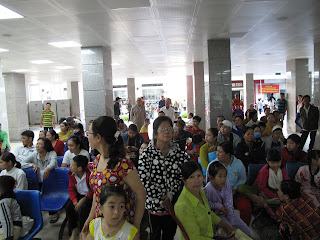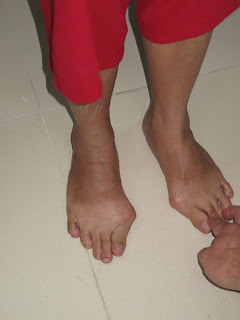On Monday, December 30th and Tuesday, December 31st, our team evaluated approximately 85-90 patients ~ adults and children ~ for possible foot/ankle surgical correction of their deformities. Of these patients, about 35 or so will undergo surgery.
The patients ranged in age from 3-4 years old to 70+ years old with a variety of diagnoses/conditions, which included club foot deformities, foot/ankle deformities due to polio, cerebral palsy, developmental delays, history of infections, due to injuries sustained in motor vehicle accidents, spina bifida and 1 child with either muscular dystrophy or spinal muscle atrophy.
We also had a number of returning patients come, who previously have undergone surgical correction of their deformity(ies) with our team in past missions. For many of these kids and adults, their outcomes are terrific and life-changing. For a few, they've had a good correction, but require a little additional surgery to get the best outcome.
Here in Vietnam, the polio vaccine is available, but many of our patients live in very rural environments and do not access healthcare, so we are still seeing some patients who are quite young getting polio and the subsequent deformities that result. In Vietnam, there really is very limited primary care, rather people only go to a hospital if they are sick or in an accident.
The hospital finds the patients for us and sets them up to come see us on the 2 screening days. They had told us there would be at least 100 patients, but we saw less than that projected number. The way we run our screening clinic is that the patients register with Kim and Amy and they are assisted by our interpreters, Mai, Chau, and Hua. They find out why the patient has come to see our team, if the patient/family know why they have the existing problem (sometimes they do, sometimes they don't, as diagnoses aren't given and often they tell us they had a 'fever,' which usually means they had polio, and that's when their deformity began) and their age. Once that information is gathered, then we have a couple of folks who take still photographs of their deformity(ies) and then video of them walking (to the camera/away from the camera).
Once that is complete, and it's their turn, then they are taken into an examination room. This year, we were in the NEW orthopedic department of the hospital (just built) and the 2 examination rooms we had were not only spacious, but also air conditioned! This was big and super-exciting. Now, the waiting area isn't air conditioned, as it is all open air, but at least during the evaluations, our team was cool(er) and the patients/families could cool down too. This was a first for us!
We have 2 surgical residents along that work with Jeff Spanko, DPM, in California, and so Jisun and Bobby, the residents, were each in 1 of the examination rooms and they, with an interpreter, would begin the evaluation of the patient. Then the physicians, Bruce, Jeff, Meir, and Ezequiel and me, as the PT, move from room to room to evaluate the patients, with each resident.
It's always a fascinating process and there is always a lot of discussion/debate about how to approach the patient's deformity and my role is to collaborate with them, considering the patient's current functional mobility, the potential for improvements and/or detriment to their current functional mobility following possible surgical intervention and ensuring we are all considering the child/adult's muscle tone and overall movements. I feel luck to be a part of this team and enjoy these evaluations and feel my opinion is valued by them all.
One of the challenges with these evaluations is that if the patient is unable to walk independently or with an assistive device, such as a cane or walker, and doesn't appear to have the potential to walk independently or with a device following surgery, these are not patients we can help with surgery. There are limitations to what our team can do. Throughout the first day of screenings, we had a number of patients who fit into this category and so Amy and I discussed flagging these patients so I could have a one-on-one conversation with their parents/families, rather than having our entire team come into the room and then say no and leave. So, on the 1st day of screenings, I spoke with 5 families directly and on the 2nd day with another 5 families and this is always such a hard discussion. These patients all had different levels of severity of cerebral palsy or other cognitive and motor impairments and they were all non-ambulatory or could only ambulate with a significant amount of assistance.
In Vietnam, no one typically will say to a parent/family that their child will not likely walk, even if they are unable to do so at 18 years of age. It is just not culturally done. Families come to our screenings with the great hope that the US/Israeli doctors will 'fix' their child or their family member's impairments, but unfortunately, we cannot fix every situation. So, I spent time with these families, with the assistance of one of the Vietnamese orthopedic surgeons, Bach Si Thuyet (pronounced "Tweet"). He was terrific, but I knew the things I was asking him to tell these families was very uncomfortable for him to say. I always try to provide the families with some positives and/or things they can work on at home with the patient, but in the end, had to explain to them all that our doctors wouldn't be able to fix their family member's problem. It was hard to do, as always, and is quite draining, but important.
One child I saw who I had to talk with her family about the fact that surgery wouldn't help her either had a form of muscular dystrophy or spinal muscle atrophy, both neuromuscular disorders that cause the child to stop walking sometime around 8-12 years of age and can be fatal, as well, depending on the diagnosis. This child was 7 years old, had begun having trouble walking at 4 years of age and had trouble standing up from the chair, getting down/up from the floor and walking, exhibiting classic signs of a neuromuscular diagnosis. So, I talked with her mom about the fact that she will likely stop walking soon and unfortunately, in Vietnam, there is limited to no accessibility and wheelchairs are expensive and difficult for most people to afford. Her mom was very sad, but thanked me for talking with her. Ugh.
Below are photos and some videos of some of the patients we saw in our screening clinic, so hopefully, this gives a picture of the severity of deformities we are seeing.
This is the waiting area of our clinic space. It is all open-air, so is quite humid and hot. The temperatures are in the 90s at this time of year with very high humidity.
Another view of the waiting area and all of the patients waiting to be seen.
This little boy was seen for evaluation and will have surgery on his club foot deformity. Here he is playing with a puppet one of our team members brought. He was quite engaging and social with everyone!
This patient is a woman in her 50s, who had an infection in her leg, causing part of her muscles to be removed and she has a lot of scarring and deformity, as a result. She will undergo surgery to correct her deformity, making her ankle much more stable for walking. In Vietnam, walking is everything, as there aren't flat sidewalks and isn't any accessibility for wheelchairs.
This is a better view of her foot/leg deformity. Initially, it was suspected she was burned, but as stated above, she had an infection in her leg, causing removal of muscles and then this resulting deformity and significant scarring.
This is her leg, but closer to her knee. You can see the level of damage from her infection, which was many years ago (maybe more than 10).
This is an approximately 18 year old with a club foot deformity on the left. He will undergo surgical correction and should be able to walk much better following stabilization and re-alignment of his ankle.
Significant bunions. She has lots of foot/toe pain with standing and walking, so will undergo correction. One question, when surgery is recommended, we always ask the patients, is if they undergo surgery will there be anyone to care for them, while they are immobilized in casts and non-weight bearing. There are times the patients cannot have surgery, as they wouldn't have anyone to care for them, bring them food, etc.
This is a man in his 60s, who also had an infection in his leg (on the left) and you can see the severity of the damage to his leg. He has significant foot/ankle deformity and will undergo correction to make walking easier for him in the long-run.
A severe cavus foot deformity, due to polio. This is where the arch of the foot becomes very high and this patient had a lot of muscle weakness and stiffness in various places, making walking difficult. This patient also has 6 toes, due to a birth deformity. These types of deformities are seen here often, likely due to the ongoing effects of Agent Orange in the ground water from the Vietnam War (or the American War, as it's called here in Vietnam).
This is a patient who had polio and you can see on their left leg that her knee is hyper-extended and her foot is curling inward and she is walking on the outside of their foot.
This is an x-ray of a patient's feet, showing the deformities they have.
A patient with an untreated deformity on the left. He will undergo surgical correction to improve his ankle's stability and foot alignment.
This is a woman with moderate diplegia cerebral palsy (meaning her legs and trunk are mainly involved). She is able to walk, but slowly, but this is much improved since her surgery in 2017. She was very happy with her outcome. She says she walks slowly, but is stable.
This gentleman had polio many years ago and you can see the significant deformity of his left leg, as his knee hyper-extends backwards quite significantly when he walks. He also has a lot of hip muscle weakness on the left. He also has some mild impairment on the right. He has a brace for his left leg that stabilizes not only his foot and ankle, but also crosses above his knee to create stability at that joint as well, dramatically changing his walking and balance. To get a brace made in Vietnam, it is very expensive and one has to have the financial resources to purchase it.
So, as you can see, it was a productive 2 days and as the week progresses, likely there will be a few more patients to be screened and possibly put onto the surgical schedule. Right now, surgeries start tomorrow and will go through next Wednesday, January 8th. The surgical team will work directly with the Vietnamese orthopedists collaboratively.
Beginning tomorrow, the 2nd, and on Friday, the 3rd, too, Amy and I will work with a pediatrician here in Can Tho, Dr. Lam, seeing approximately 28 patients with Autism. Amy will, of course, take-the-lead, as this is her area of specialty, as a Speech-Language Pathologist, but I will help in any way I can.
Having a great time!
xoxo
Stacy
















No comments:
Post a Comment